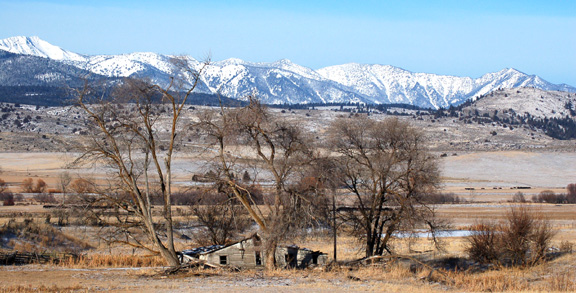In this Edition:
- Bad Information on Crypto?--Don't Blame the Herald--Look to the Source
- Cyclical Outbreak of Elm Leaf Beetle in Baker City[Edited 11/6/11, 6/25/12 (corrected ID of my elm trees--Siberian--not American.)]
[11/17/11--See also the next blog:
Accountability for Baker City's Cryptosporidium Fiasco--is the elephant still in the room?]
_____
Bad Information on Crypto?--Don't Blame the Herald--Look to the SourceWhen I first heard that testing results had been provided to the city revealing that Cryptosporidium (Crypto) had been identified in the city water supply as early as April of 2010, I was as shocked as anyone, given the repeated denials by the city staff of its existence. I was puzzled as to why all 24 lab reports, a years worth, were all date stamped September 2, 2011 by the state, some 17 months after testing had begun and over 5 months after it had ended. At Tuesday's Council Meeting, all the City Manager had to say about the discovery was: "In September the staff of Baker City became aware that as a result of the tests that we had been conducting for Cryptosporidium we had had some positive test results." No discussion of why it had not been reported to Council or the public prior to late October and early November, even though the first of three positive detections came in about 18 months earlier. Now we are informed by the Herald that public works director Michelle Owen said "she looked at some, but not all, of the lab reports." Ho Hum--after all--it is just a potentially deadly pathogen in the water supply of a city of roughly 10,000 people. Good to know we've got public works looking out for us. Yikes!
Having been reluctantly convinced by the Herald's recent editorial,
"Baker City's dilemma" (Oct. 27, 2011) that treatment was the best way to proceed, so as to avoid costly legal battles, fines, and etc., even though we all thought Crypto hadn't been yet detected, one of my responses to the disclosure was that it might make some question the Herald's credibility. Such accusations, if offered, would be misdirected though, because the Herald was depending upon the city to provide accurate information, which the Herald dutifully reported. One would hope that we can trust at least our local government to be doing the job they are well paid to do, and if you can't trust them to give you accurate information, who can you trust?
Perhaps that view is a little naive, but one can hardly blame the Herald for reporting in good faith the information that was given to them by the city, and there was no indication from any other governmental source that things might be amiss. (There are systemic reasons for that which I hope to address in a later post on this subject.) The Herald and the Council, like anyone else, will be more skeptical once burnt, but on issues of trust related to the very basic and important issue of public health, as opposed to street maintenance and contract issues, I am unaware of any reason why they wouldn't take the Public Works Department seriously. Who could imagine the Public Works Department not taking care to read all the lab results and to immediately report matters of such import to the Council and the public?
That's why I was surprised by yesterday's politic and gracious editorial, "
The story behind the crypto mistake," wherein the Herald Editorial Board says "We messed up. . . . . We were wrong."
On many occasions, as a blogger, I have to rely on information from government sources, when I can pry it out of them. The information is often not easily questioned due to technical issues, time, legal hassles, and budgetary constraints, among other reasons. That's why the public and media in general look for both trust and competency in their public officials, while retaining a healthy skepticism. But Crypto in the water supply? What responsible and competent public official wouldn't be on top of that?
Upon watching the special Council work session called for last Tuesday, and looking at the test results provided (at last) in the
Council Packet, many questions arose within the public and myself as to the process used for reporting important data on our water quality. While I did initially spend some time researching the subject, the prediction of the winter storm now upon us compelled me to tend to important fall chores, such as putting the garden to bed and keeping the property maintenance police off my back, so it was not until yesterday I was able to speak with the regional state drinking water department and testing labs, etc. To make a very long and complicated story much shorter, and using today's Herald editorial as a base for correcting misunderstandings (without adding too many of my own I hope) here is a summary of what I was able to find out.
The Herald editorial stated that "
. . . cryptosporidium, [is] a parasite that can cause diarrhea and vomiting."
While they had previously reported that 50 people died in the Milwaukee, Wisconsin outbreak of the 1990's, they might have more accurately stated that cryptosporidium is a parasite that can cause diarrhea, vomiting, and
death. According to
Wikipedia, "At least 104[2] deaths have been attributed to this outbreak, mostly among the elderly and immunocompromised people, such as AIDS patients."
Another
report, from the School of Veterinary Medicine, University of Wisconsin-Madison, states that:
The organism is highly infectious.
The median infective dose (from human trials!) is only 132 oocysts, and 20% of human subjects could be infected with as few as 30 oocysts!
While it is true that people exposed to Cryptosporidium when healthy may often form a degree of immunity to it, it still poses the risks mentioned above to many other folks, especially the previously unexposed, sick, elderly, or immunocompromised. There is also the possibility that locally, there are sometimes more than 0 to 2 oocysts in every ten liters of water. One lab professional I spoke with yesterday said that given the very small 10 liter sample size, compared to the much, much larger volume of water passing through the system, combined with other variables such as seasonal stream conditions, proficiency and technique of the sampler, etc, one could expect high variability in the actual numbers at any given time and that the standard deviation of results "could be all over the place." I take that to mean that it could be expected that sometimes there are far more oocysts in a given volume of our drinking water than is indicated by the lab results which reflect only 24 samples over a one year period.
The Herald also states that "Nor does the presence of crypto affect the city’s ongoing planning for installing an ultraviolet light system, at an estimated cost of $2.5 million, that inactivates the parasite."
Our surface water source is an unfiltered source of water. According to information provided by the state and EPA (
Treatment Rule: A Quick Reference Guide For Schedule 4 Systems), there is a difference in in the UV system needed depending upon whether Crypto has been detected or not. If no Crypto had been detected, we would still need a 2-log (99% crypto inactivation) system, which is less expensive (marginally perhaps) than a 3-log system (99.9% inactivation) which is required when Crypto has been detected. A minor detail.
Perhaps the most important (and most politic) clue to the Crypto mystery is this part of the
editorial:
She [Michelle Owen] told us that there was no sign of crypto.
Then we learned this week about the three positive tests.
The explanation for the discrepancy, Owen told us on Thursday, is that while the tests were being done, she looked at some, but not all, of the lab reports.
. . . .
Owen said she believed, when she told us that none of the city’s water samples tested positive for crypto, that she was speaking truthfully.
She said she learned that wasn’t the case late this summer, when the city compiled the 24 lab reports to send to the Oregon Health Division’s Drinking Water Program.
Owen said she realized then that three reports — ones she hadn’t read before — indicated small amounts of crypto were present.
Hmmmmm.... Like I said, the Herald is very gracious. . . .

Michelle Owen, Public Works Director
Before I had a chance to see the Herald yesterday, I spoke with the Oregon Health Authority's drinking water program and both laboratories involved in the Crypto analyses.
BioVir laboratory (2011 results) said they were sub-contracted by the original Lab/Cor, Inc. laboratory contractor (2010 results), and sent the results to them fairly quickly. Lab/Cor said they sent the results to the city public works Water Plant Specialist Jake Jones within two weeks of the actual test.
So we are expected to believe that no one at public works took the time to read
every one of these important reports about the presence or absence of a potential deadly pathogen in our water supply? Again, it's good to know we've got public works looking out for us!
Bill Goss, from the Oregon Health Authority regional office in Pendleton, said that while in some cases the results are sent to the state office in Portland, the lab results for Baker City are sent directly to the public works department. Apparently the regional representative was not previously completely aware of the Federal requirement for city water systems (city public works) to "report [to the state] results from the source water monitoring no later than 10 days after the end of the first month following the month when the sample is collected," but he claims to be out of the loop anyway because the results were supposed to have been sent by public works to the Portland office, not Pendleton, within the specified time frame.
A state representative said the reports, which were supposed to be sent regularly to the state office in Portland, were often not tracked or scrutinized there until the end of the yearly reporting period, at which time they were reviewed to determine the appropriate level of water treatment needed. Given that the state office did not report regularly to the regional representative, the regional representative would not know of the positive findings for Crypto, had they actually been sent to Portland. Additionally, the regional representative stated he was informed verbally by Michelle Owen at the late 2010 Council meeting (8/24/10) that Crypto had not been detected in our water.
Here's the rule:
333-061-0040 Reporting and Record Keeping(1) Reporting requirements:
(m) Reporting source water monitoring results for Cryptosporidium and E. coli collected in accordance with OAR 333-061-0036(5)(e). Water systems must report results from the source water monitoring no later than 10 days after the end of the first month following the month when the sample is collected as prescribed by this subsection.Well, the reports, dating back to April, 2010, were not received by the state until September 2, 2011 (you count the months). Several violations here.
And then there is the question of this year's required Consumer Confidence Report, provided by the city for the public, which did not report the presence of Crypto to the Baker City public, even though it had been reported to the city as being present in April and October of 2010, as well as in January or this year. Another clear violation. Consumer Confidence?
Here's the rule:
333-061-0043 Consumer Confidence Reports(3) Detected Contaminants:
(m) Information on Cryptosporidium, radon, and other contaminants:
(A) If the system has performed any monitoring for Cryptosporidium,
which indicates that Cryptosporidium may be present in the source water or the finished water, the report must include:
(i) A summary of the results of the monitoring, and
(ii) An explanation of the significance of the results.The Herald editorial stated that:
Nor is the city required to report the presence of crypto — unlike with other contaminants, such as E. Coli, the state doesn’t have a protocol for when cities must notify either the state or the public about possible crypto contamination, Goss said.
Given the information provided above from multiple sources, that statement is not entirely accurate
Both the state representative and the EPA have clarified that the city [public works department] was required to report a finding of Crypto in the water supply in their annual Consumer Confidence Report that must be sent out by July first of every year.
While there appears to be enough blame to go around in this case, from the information available, one should look to government, not the local paper, for the real culprits. If anything, the Herald set a good example by accepting some responsibility, however slight it may be in reality, for passing on bad information. It is truly a shame that the public works department didn't do the same, along with issuing an apology to the people and the Council, as soon as they realized their careless handling of the lab reports.
__
 Centers For Disease Control--Cryptosporidium Life Cycle
Centers For Disease Control--Cryptosporidium Life CycleFor more information on Cryptosporidium, see also:
Selected Zoonotic Agents of GastroenteritisCattle:
The domestic animal of most importance as a reservoir of Cryptosporidium parvum is clearly cattle.
-
Epidemiologic Aspects of Human Cryptosporidiosis and the Role of Waterborne Transmission(Use search facility to get to page where you can download article.)
_____
Cyclical Outbreak of Elm Leaf Beetle in Baker CityThis past summer, I was a bit chagrinned to see numerous little tan-brown beetles with dark racing stripes milling about the house, both inside and out, and hiding towards fall under the bark of some of my firewood. My first thought was that they might be some sort of wood boring beetle whose larval stage had been eating away at my house. They had been around in previous years, but never in the numbers seen this summer.
I was relieved to find out upon investigation, that, rather than attacking my house, these beetles were chewing up the leaves on my old Siberian Elms (
Ulmus pumila), planted by previous owners of the property, and that I was experiencing an outbreak of the Elm Leaf Beetle (
Xanthogaleruca luteola).

Elm Leaf Beetle clinging to screen door.
The adults seen under the bark of my firewood had gone there seeking a shelter for winter hibernation, although that ultimately could prove to have been a "bad choice." They also seek winter quarters in houses. Those that remain in the spring will fly or crawl up into the elms again to lay eggs on the lower surface of leaves, and when the larvae hatch in about a week, they will begin feeding on this lower leaf surface. The effects can be seen in the next photo.

Effects of Elm Leaf Beetle larvae feeding on the underside of elm leaves.
After feeding, the larvae then migrate down to the larger crack and crevices in the bark of the tree where they develop into the adult beetles which emerge in summer. Adult beetles feed on the leaves as well, leaving spots or holes seen on the upper surfaces.

Effects of Elm Leaf Beetle adults feeding on the upper surface of elm leaves.
Having grown up in an area with few of the large elms found in Baker City, I had not experienced these little delinquents until moving here. The literature assures me that while they weaken the tree, they do not normally kill it. Treatment is problematic, but
Wikipedia suggests the following:
In North America, there are few natural enemies, but in Europe, the ova of the beetle are often heavily predated by the chalcidoid wasp Oomyzus gallerucae [2]. Insecticide sprays are of little use since by the time the infestation is apparent, the application will be too late to be effective. However, tree trunks banded with insecticides can limit repetition the following year by killing the larvae as they descend before hibernation.
My view? Don't bother.
Other Links:
U of M Extension Elm Leaf BeetleLEAST TOXIC AND ORGANIC PESTICIDES FOR GARDENERSBiological Insecticides
Bt (Bacillus thuringiensis)
Source: naturally occurring bacterium produced en masse in the lab Mode of action: bacterial stomach poison that must be ingested by insect to be toxic, initial poisoning causes cessation of eating, insect dies in a few days Uses: Bt kurstaki used against plant-eating caterpillars, Bt israelensis used against mosquitoes and fungus gnats, Bt san diego used against elm leaf beetle and Colorado potato beetle Toxicity: mammalian toxicity varies from low to very low toxicity depending on product Products: Caterpillar Killer, Dipel, Gnatrol, Bactimos, Potato Shield
Miscellaneous Garlic
Notes: biodegrades quickly in sunlight, spray late in day or on a cloudy day, need full plant coverage, Bt kurstaki works best when caterpillars are still small























